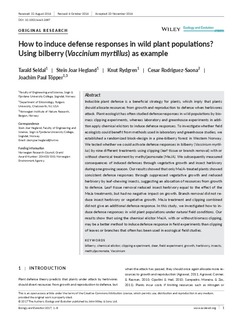| dc.contributor.author | Seldal, Tarald | |
| dc.contributor.author | Hegland, Stein Joar | |
| dc.contributor.author | Rydgren, Knut | |
| dc.contributor.author | Rodriguez-Saona, Cesar | |
| dc.contributor.author | Töpper, Joachim Paul | |
| dc.date.accessioned | 2017-02-23T07:03:05Z | |
| dc.date.available | 2017-02-23T07:03:05Z | |
| dc.date.issued | 2017 | |
| dc.identifier.citation | Ecology and Evolution, 2017 | nb_NO |
| dc.identifier.issn | 2045-7758 | |
| dc.identifier.uri | http://hdl.handle.net/11250/2431846 | |
| dc.description.abstract | Inducible plant defense is a beneficial strategy for plants, which imply that plants should allocate resources from growth and reproduction to defense when herbivores attack. Plant ecologist has often studied defense responses in wild populations by biomass clipping experiments, whereas laboratory and greenhouse experiments in addition apply chemical elicitors to induce defense responses. To investigate whether field ecologists could benefit from methods used in laboratory and greenhouse studies, we established a randomized block-design in a pine-bilberry forest in Western Norway. We tested whether we could activate defense responses in bilberry (Vaccinium myrtillus) by nine different treatments using clipping (leaf tissue or branch removal) with or without chemical treatment by methyljasmonate (MeJA). We subsequently measured consequences of induced defenses through vegetative growth and insect herbivory during one growing season. Our results showed that only MeJA-treated plants showed consistent defense responses through suppressed vegetative growth and reduced herbivory by leaf-chewing insects, suggesting an allocation of resources from growth to defense. Leaf tissue removal reduced insect herbivory equal to the effect of the MeJa treatments, but had no negative impact on growth. Branch removal did not reduce insect herbivory or vegetative growth. MeJa treatment and clipping combined did not give an additional defense response. In this study, we investigated how to induce defense responses in wild plant populations under natural field conditions. Our results show that using the chemical elicitor MeJA, with or without biomass clipping, may be a better method to induce defense response in field experiments than clipping of leaves or branches that often has been used in ecological field studies. | nb_NO |
| dc.language.iso | eng | nb_NO |
| dc.publisher | Wiley | nb_NO |
| dc.rights | Navngivelse 4.0 Internasjonal | * |
| dc.rights.uri | http://creativecommons.org/licenses/by/4.0/deed.no | * |
| dc.subject | bilberry | nb_NO |
| dc.subject | chemical elicitor | nb_NO |
| dc.subject | clipping experiment | nb_NO |
| dc.subject | deer | nb_NO |
| dc.subject | field experiment | nb_NO |
| dc.subject | growth | nb_NO |
| dc.subject | herbivory | nb_NO |
| dc.subject | insects | nb_NO |
| dc.subject | methyljasmonate | nb_NO |
| dc.subject | Vaccinium | nb_NO |
| dc.title | How to induce defence responses in wild plant populations? Using bilberry (Vaccinium myrtillus) as example | nb_NO |
| dc.type | Journal article | nb_NO |
| dc.type | Peer reviewed | nb_NO |
| dc.rights.holder | The authors. | nb_NO |
| dc.source.journal | Ecology and Evolution | nb_NO |
| dc.identifier.doi | 10.1002/ece3.2687 | |
| dc.identifier.cristin | 1465262 | |

